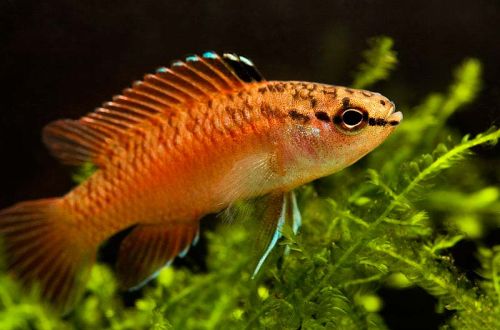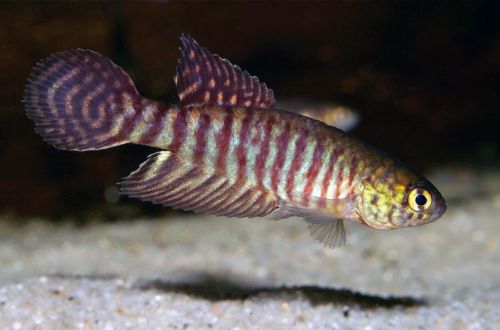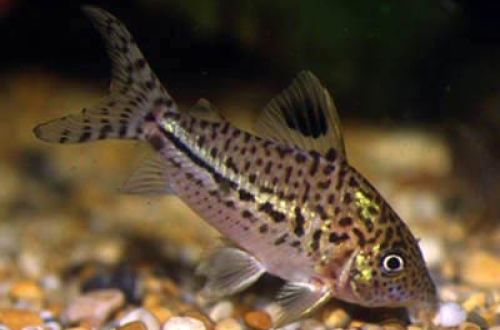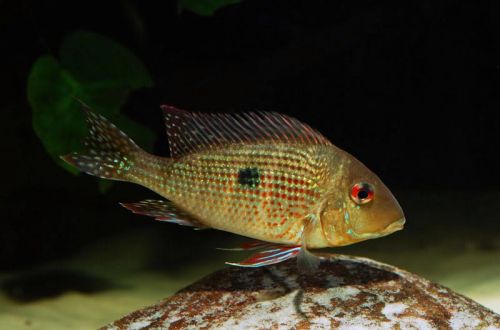
Dario Cajal
Dario Kajal, scientific name Dario kajal, belongs to the Badidae family. For the first time as an independent species, the fish was identified in 2013. Up to this point, it was referred to as Dario “Bangladesh”.

Contents
Habitat
The fish is native to Asia. The first samples were collected in the Meghna River basin, one of the three largest rivers in Bangladesh. And the fish that received the scientific name were caught in the Indian state of Meghalaya, located on the northeastern border with Bangladesh.
Dario Kajal inhabits small streams and rivers with stagnant muddy water with a small amount of aquatic vegetation. The habitat receives a large amount of precipitation, so the composition of the water and the level of the rivers will change significantly during the year.
Description
Adults reach a length of about two centimeters. The coloration is reddish. There is a pattern of dark specks on the back. On the edges of the dorsal and pectoral fins there is a turquoise edging.
A characteristic feature of the species is the presence of a black stroke on the eyes, which is reflected in the name of the species. Kajal in Hindi means “black eyeliner” used by Indian dancers when performing traditional dances.
Females look less bright. The main colors are gray or silver with a faint red pigment, giving the fish a pale pink hue.
Behavior and Compatibility
Males compete with each other for territory and the attention of females. In a small aquarium, two or more males should not be placed.
Calm, slow-moving fish that will not be able to compete for food with more active neighbors. Only very small peaceful fish such as Rasboras, Guppies should be considered as compatible species.
Brief information:
- The volume of the aquarium – from 40 liters.
- Temperature – 18-24°C
- Value pH — 6.5–7.5
- Water hardness – 5–15 dGH
- Substrate type – any soft
- Lighting – subdued
- Brackish water – no
- Water movement – little or no
- The size of the fish is about 2 cm
- Feed – any food of suitable size, preferably live or frozen
- Temperament – peaceful
- Content – in a small aquarium in a pair of male / female or in a harem
Maintenance and care, arrangement of the aquarium
The optimal size of the aquarium for a group of 3-4 fish starts from 40 liters. The design uses a soft substrate and forms shelters from natural snags, fallen leaves of some trees. Plants that can grow on driftwood, such as Anubias, numerous aquatic mosses, and ferns, are good choices. For planting on the ground, Cryptocoryne species are suitable.
Water conditions can be in a relatively wide range of pH and GH values. Temperature matters a lot. 16-24°C are considered comfortable. Higher values negatively affect the well-being of the fish, they lose their color and become susceptible to diseases.
Thus, Dario Cajal can be kept in unheated tanks, and additional cooling may be required during the hot summer months.
Food
In nature, it feeds on small aquatic crustaceans, worms, insect larvae and other zooplankton.
As a rule, does not accept dry food. In a home aquarium, live or frozen brine shrimp, daphnia, etc. will need to be fed.
It is noted that feeding with bloodworms leads to problems with digestion and, as a result, the occurrence of diseases against this background.
Breeding / breeding
The breeding strategy is similar to other representatives of the genus (Badis Scarlet, Dario red). With the approach of the breeding season, the male occupies an area at the bottom of the aquarium, the center of which is some kind of shelter, and begins to attract females.
In large tanks with multiple males, in most cases, only one will dominate and claim breeding.
Having accepted courtship, the female lays eggs on the lower surface of the leaf. This is where spawning ends for her. The male stays close to the clutch for protection. The protection of the territory lasts the entire incubation period, which takes 2–3 days.
The fry that appear for about a week feed on the remains of their yolk sac. Then they begin to swim in search of food. Feed with microfood, for example, ciliates, then Artemia nauplii, or specialized products for fry (suspensions, powders).
It is more convenient to feed juveniles in a separate tank.
Sources: fishbase.de, researcharchive.calacademy.org





